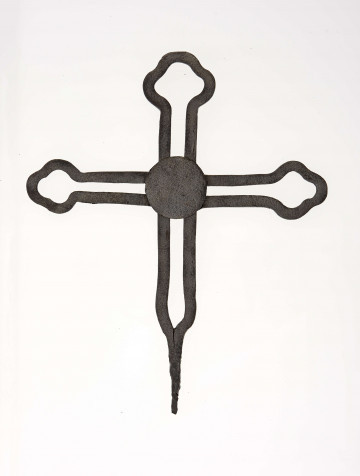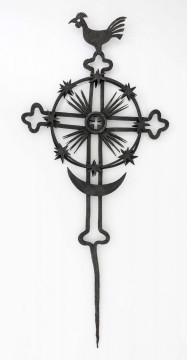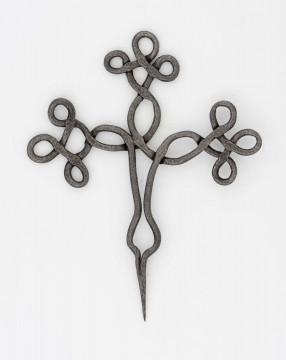
Cross
1901 — 1920
National Museum in Lublin
Part of the collection: Folk craft of the Lublin Region (19th/20th c.)
Crosses of wood, stone or iron were an inseparable element of the Polish landscape, often marking the borders of "small fatherlands". They were erected for special occasions: on days of joy or at the time of mourning, in memory of the dead, or as a prayerful sigh. The forms of wooden crosses in the Lublin region were various - from simple ones made of rough wood to those with very rich ornamentation. The crosses found on the border of the poviats of Lublin and Łęczna were distinguished by a characteristic type of brackets surrounding the crossing of arms, taking the form of a halo with gentle curves, and crosses from Biłgoraj and Janów with a narrow gabled roof and a decoratively cut out bottom. Some were additionally crowned with small crosses made by a blacksmith.
Iron crosses were made in Poland since the beginning of the 18th century. They were quite common in the Lublin region, even though in the eastern areas, mainly in the Chełm region, at the end of the 19th century, during the period of religious oppression applied by the tsarist government, erecting small-architecture cult objects was forbidden. Their great variety of forms, from very simple to extremely elaborate, testifies to the skills and creativity of folk smiths and to the great demand of the population for this type of product. Based on the crosses which still remain, it is possible to judge that their beauty owes more to their shapes than to the ornamentation with the use of beading or stamping techniques.
Top crosses with a Latin cross silhouette constituted the vast majority. They were often decorated with additional elements of various stylizations: rays, a rooster (see E/379/ML, E/16369/ML) or a crescent (see E/8115/ML). They also took the shape of a Lorraine cross, and were believed to have magical protection against 'morose air' (see E/6390/ML). The openwork ones from the area of Janów Lubelski were very original and not found in other regions (see E/5520/ML). The simplest varieties, created by crossing two flat arms, were also found in multiplication as in the case of the cross from the Zawieprzyce chapel from 1868, in which six crosses were joined by a circle.
Author / creator
Dimensions
cały obiekt: height: 16,5 cm, width: 38,5 cm
Object type
cross
Technique
forging
Material
iron
Creation time / dating
Creation / finding place
Owner
The National Museum in Lublin
Identification number
Location / status

1901 — 1920
National Museum in Lublin

1901 — 1920
National Museum in Lublin

1901 — 1920
National Museum in Lublin
DISCOVER this TOPIC
National Museum in Szczecin
DISCOVER this PATH
Educational path